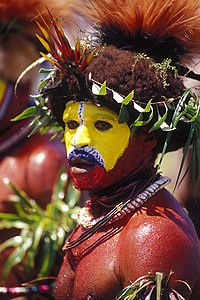|
Huli language
Huli is a Tari language spoken by the Huli people of the Hela Province of Papua New Guinea. It has a pentadecimal (base-15) numeral system: ngui means 15, ngui ki means 15×2 = 30, and ngui ngui means 15×15 = 225. Huli has a pandanus language called tayenda tu ha illili (bush divide taboo) used for collecting karuka nuts (anga) as well as hunting or traveling.[2] Tayenda is used to evade malevolent bush spirits.[2] The grammar for Tayenda is nearly identical to normal Huli, but the vocabulary is changed, often borrowing words from Duna but with changed meanings.[2] PhonologyHuli has a syllable structure of (C)V. Vowels
/ɑ/ is pronounced more fronted as [æ] before /r/ and /ʝ/.[3] Vowel nasality is phonemic in the language. Vowels can also carry three phonemic tones; high-falling, mid-level, and low-rising. Consonants
Stops /p t k/ can become aspirated as [pʰ tʰ kʰ]. Many speakers pronounce /t/ as [s] before /i/. /d/ is realized as voiceless as [d̥] when occurring word-initially, and is palatalized as [dʲ] between /i/ and a word-final /ɑ/. /r/ only occurs word-medially. /b ɡ/ can be phonetically realized as fricatives intervocalically as [β ɣ]. References
External links
|
||||||||||||||||||||||||||||||||||||||||||||||||||||||||||||||||||||||||||||||||||||||||||||||
Portal di Ensiklopedia Dunia
